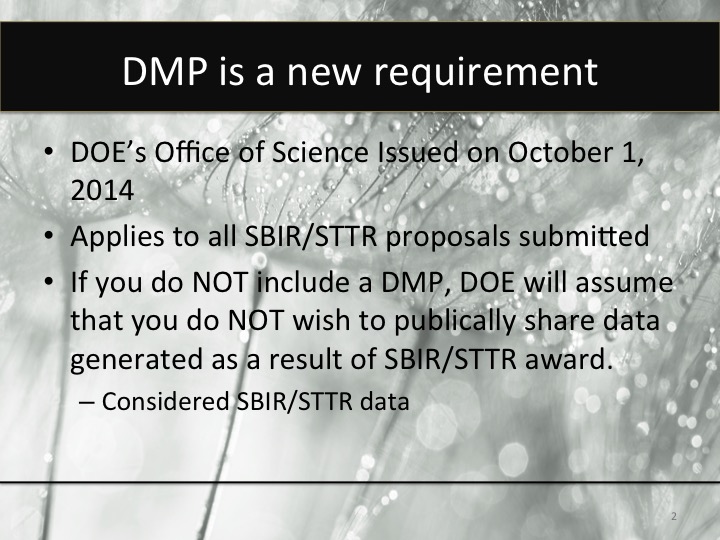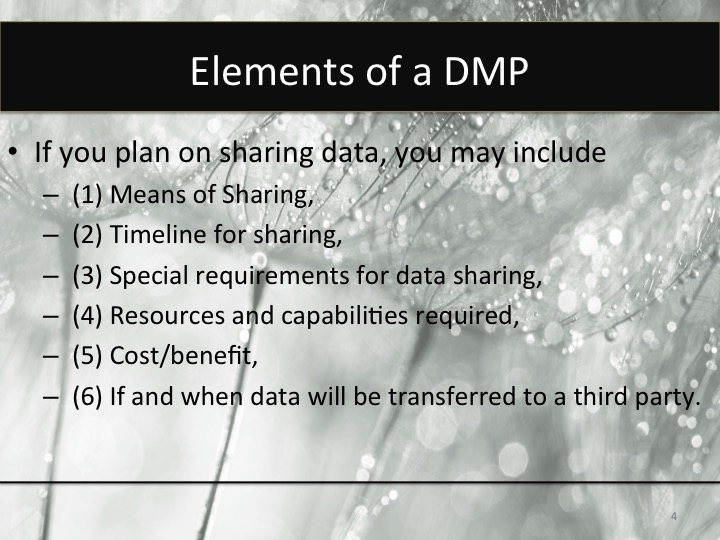Tutorial 14:
How do I prepare a Data Management Plan (DMP)?
One of the attachments that must be submitted with a DOE Phase I SBIR/STTR application is a Data Management Plan, also referred to as a DMP. This is a relatively new requirement brought about by the Department of Energy’s Office of Science requirement issued on October 1, 2014. This requirement applies to all SBIR/STTR proposals submitted in response to an SBIR/STTR Funding Opportunity Announcement (FOA). Please note that if you do not include a DMP with your SBIR/STTR application, DOE will assume you do not wish to publically share any data generated as a result of an SBIR/STTR award. However, if you plan to publicly disclose generated digital data, you must provide a DMP. Before looking at what needs to go into your DMP, let’s review the rationale for a DMP.
During the course of conducting your research – data will be generated. The data are likely to be in electronic format and are therefore referred to as digital data. Please note, if you intend to publically share digital data, the purpose of the DMP is to explain how these data will be preserved and shared. Quoting a DOE reference document – “Effective data management has the potential to increase the pace of scientific discovery and promote more efficient and effective use of government funding and resources. Data management planning should be an integral part of research planning.”
With SBIR/STTR research two different scenarios are likely to exist with respect to dissemination of digital data: Option (1) none of the data will be publically disseminated, or Option (2) some of the data will be disseminated through peer reviewed publications. According to the DOE FOA, “In cases where none of the data generated as a result of the grant will be shared, a sufficient DMP would include the following statement, “It is anticipated that all generated digital data will be protected as SBIR/STTR data and therefore will not be publicly shared during the applicable SBIR/STTR data protection period.” As any digital data will be at least 4 years old when it is no longer protected SBIR/STTR data, the effort to release such data will exceed any potential impact or value of the actual release. If any data generated under this award is published, an effort will be made to also release any related digital data that is not protected SBIR/STTR data.” Please note that if you do not include a DMP with your application, Option 1 for the DMP will be assumed for your application.
In order to advance scientific knowledge, the Office of Science encourages applicants to “consider the potential benefits of their data to their own fields of research, fields other than their own, and society at large.”
Let’s assume for example that some data resulting from your research you may wish to share via peer reviewed publications. In this case you would need to have a more extensive DMP in accordance with the guidelines provided in the FOA and the Office of Science Guidelines. The additional elements of the DMP might include the following: (1) Means of Sharing, (2) Timeline for sharing, (3) Special requirements for data sharing, (4) Resources and capabilities required, (5) Cost/benefit, (6) If and when data will be transferred to a third party. Not all of these elements are required – but may be depending upon the situation. If you plan to publicly disclose technical data during the data protection period or, for data not expected to be asserted as protected SBIR/STTR rights data, please submit a DMP in accordance with the requirements of the Office of Science Statement on Digital Data Management. An example of a simple DMP where the company’s intent is to share some data is provided in the printed version of this presentation.
The key point to remember is that you will need to submit a Data Management Plan (DMP) with your proposal to DOE. The plan does not need to be complicated in order to meet the requirements identified in the FOA. If you are working with a Federal Lab it is important to discuss the terms of a DMP with them – as the lab is likely to have its own guidelines.
Quiz: Tutorial 14: How do I prepare a Data Management Plan (DMP)?
1
Which of the following is a true statement regarding Data Management Plans
Nice Work
Try Again
2
Which of the following is the most complete description of the purpose a Data Management Plan:
Nice Work
Try Again



